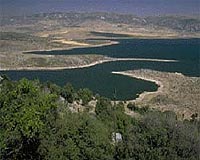| . |  |
. |
Monster, Netherlands (AFP) Nov 20, 2009 On the beach at Monster, bulldozers painstakingly turn sand dredged from the bottom of the North Sea bed into dunes in an ambitious effort to safeguard the Netherlands from flooding. Stretching more than 20 kilometres (15 miles) southwards from The Hague, the project is one of many in a never-ending battle against rising sea levels attributed to global warming. "Because it is a low-lying delta, the Netherlands is very sensitive to climate change," Water Management Deputy Minister Tineke Huizinga told AFP on a recent visit to the bustling work site. "If sea and river levels rise, the Netherlands will be under threat," Huizinga said, walking in yellow boots along a pipeline of several hundred metres (yards) spewing out dredged sand. "Fortunately, the coast is safe today, but we are investing in the security of people who will live here in 50 years." More than 18 million cubic metres of sand -- enough to fill 7,200 Olympic-sized swimming pools -- are set to be poured onto the new coastal band of dunes until 2011. The project got underway last year at a total cost of 130 million euros (about 200 million dollars) to the Dutch state. Sand is dredged from the bottom of the North Sea, about 15 kilometres from shore, by two specialised vessels that work in turns, day and night, before being relayed to the beach via the pipeline. Bulldozers then amass the sand to create the dunes, broaden the beach and gain territory from the sea, metre by metre. "We had no choice but to extend the coast towards the sea," the area's flood prevention chief Michiel van Haersma Buma told AFP. "Our coast is relatively narrow. Houses and greenhouses lie just beyond the dunes. This area is so densely populated that we had no space to construct more dunes and dykes further inland." The new dunes -- 30 to 60 metres wide, and rising up to 10 metres above sea level -- are going up next to an existing band of dunes. Covering them is a special type of grass with long roots to keep the sand intact. "The more dunes there are, the less sea water can infiltrate," thus reducing the danger of contamination of fresh water inland, Haersma Buma explained. When completed, the project would have made the 20-kilometre stretch of dune-lined beach up to 200 metres wide at low tide, compared to 180 metres at present. The economic stakes are high: Up to 65 percent of the Netherlands' gross domestic product comes from areas that are located below sea level. "We want to to be able to live and work in security," Huizinga said. "It is a big investment. But the cost of protecting this area is a fraction of the cost that a flood would cause to the economy -- and that does not even take into account the social disruption and loss of life." The government is due to unveil a new programme next year for protecting the nation from water-related consequences of global warming, at a cost to the state of around one billion euros (1.5 billion dollars) per year from 2020, water ministry spokeswoman Marie-Christine Lanser-Reusken told AFP. In September last year, a government-appointed commission warned that the Netherlands must spend more than 100 billion euros over the next century on dike upgrades and coastal expansion. The Delta commission predicted a sea level rise of between 0.65 and 1.3 metres (2.15 and 4.3 feet) by 2100, and said about nine million of the country's 16 million inhabitants already lived in areas directly shielded from the sea and rivers by dikes and dunes. Floods in 1953 killed 1,835 people and left 72,000 homeless when a total 200,000 hectares of land in the southern provinces of Zeeland, Noord Brabant and Zuid-Holland were inundated.
Share This Article With Planet Earth
Related Links Water News - Science, Technology and Politics
 Fighting the 'water war'
Fighting the 'water war'Beirut, Lebanon (UPI) Nov 6, 2009 U.N. Deputy Secretary-General Asha-Rose Migiro said the Middle East is "in a challenging situation" and would need stability to achieve development, emphasizing the need to fight climate change to help avoid the next major conflict in the embattled region: "Water War." "Instability does affect (development). This is clear: Where you have instability, you cannot make development. But whe ... read more |
|
| The content herein, unless otherwise known to be public domain, are Copyright 1995-2009 - SpaceDaily. AFP and UPI Wire Stories are copyright Agence France-Presse and United Press International. ESA Portal Reports are copyright European Space Agency. All NASA sourced material is public domain. Additional copyrights may apply in whole or part to other bona fide parties. Advertising does not imply endorsement,agreement or approval of any opinions, statements or information provided by SpaceDaily on any Web page published or hosted by SpaceDaily. Privacy Statement |